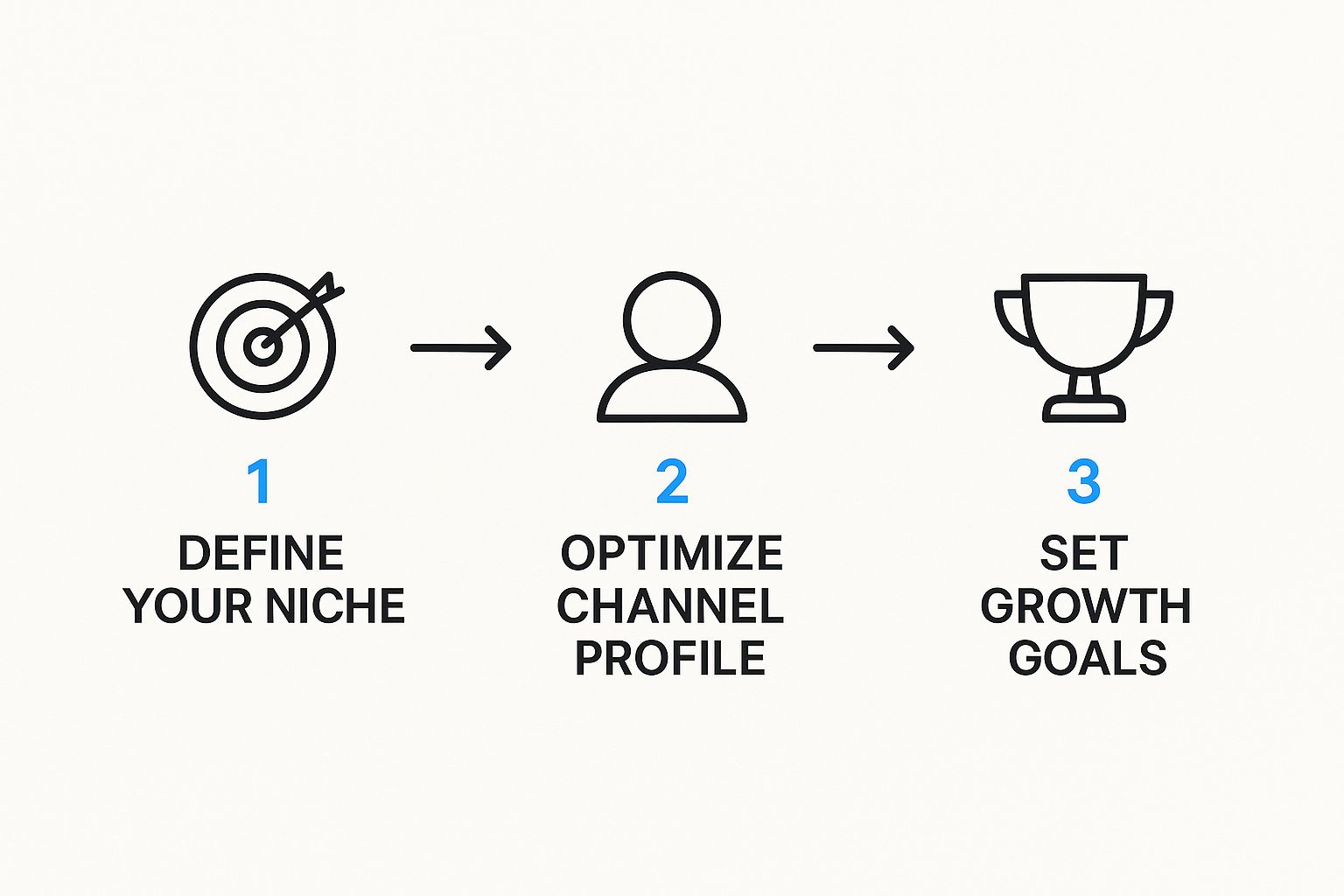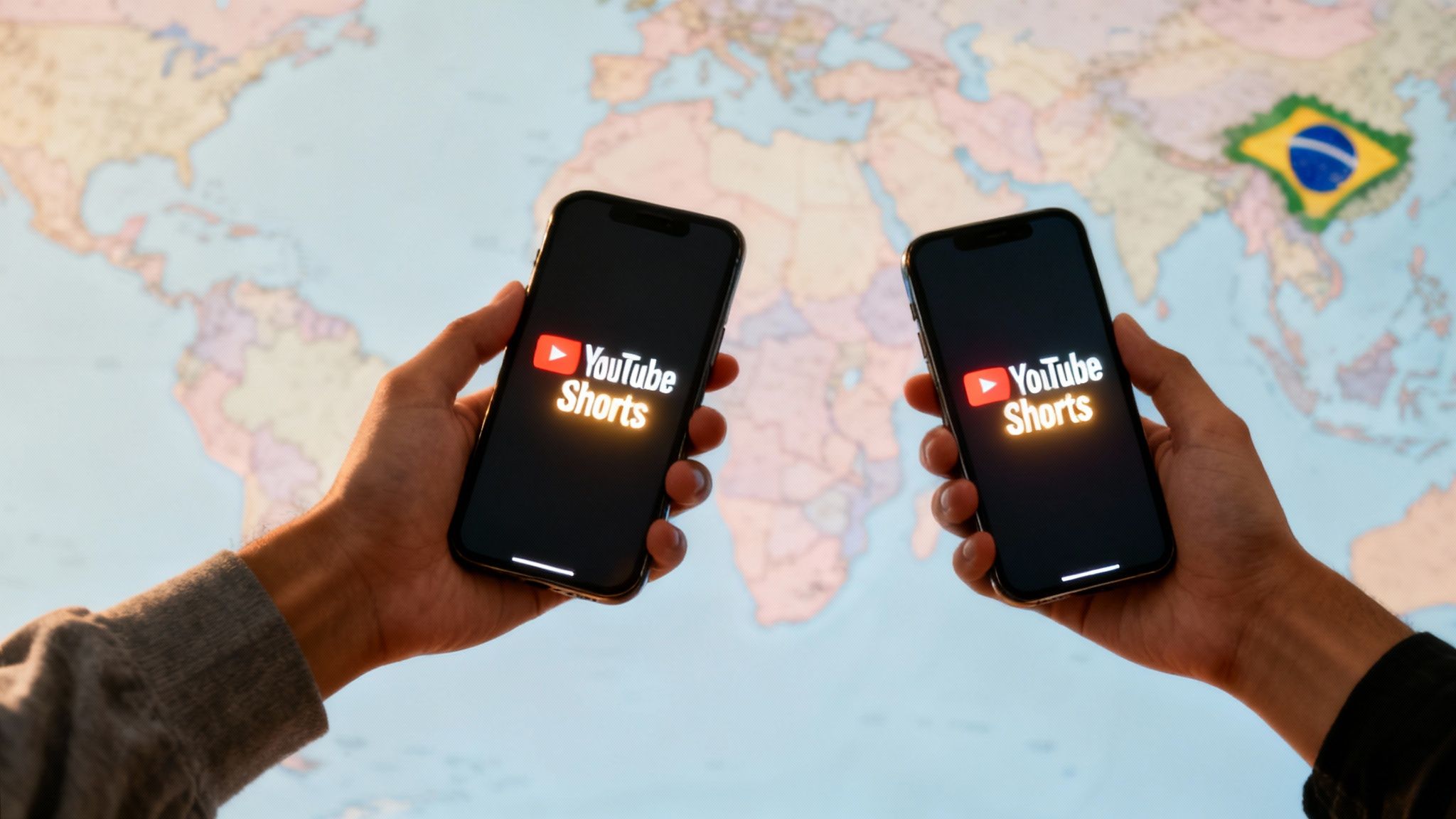How to Grow on YouTube Shorts Proven Strategies
To really grow on YouTube Shorts, you need a three-part game plan: create content that hooks people instantly, optimize everything for the algorithm, and post like you mean it. It all boils down to grabbing attention in the first three seconds, holding it with a great story, and making something so good people want to watch it again and share it.
Building Your Foundation for Shorts Success
Before you even dream up your first video, you have to get your head around the unique world of YouTube Shorts. This isn't just a smaller version of regular YouTube—it’s a totally different beast where fast-paced, snackable content is king. The algorithm rewards videos that get an immediate reaction, which makes setting up a solid foundation more critical than ever.
The opportunity here is massive. Viewership has absolutely exploded, jumping from 30 billion daily views in 2021 to over 70 billion by late 2023. With more than 2 billion logged-in users scrolling through Shorts every month, it’s a powerhouse for short-form video. You can dig into more of the latest stats on this incredible growth to see just how big it is.
Define Your Niche and Content Pillars
The first real step is figuring out who you are and what your channel is all about. A channel that's too broad or vague will struggle to get any momentum because the algorithm won't have a clue who to show your videos to.
Don't try to be everything to everyone. Instead, lock in on a specific niche you're actually passionate about. Are you a fitness coach? Skip the generic "fitness tips." Get specific with something like "at-home workouts for busy parents" or "bodyweight exercises for total beginners." That kind of clarity helps you pull in a dedicated audience that will actually stick around.
Once your niche is set, map out your content pillars. These are the 3-5 core topics you’ll build your channel around. For example, a cooking channel’s pillars might be:
-
Quick 15-minute recipes
-
Budget-friendly meal prep ideas
-
Reviews of must-have kitchen gadgets
This structure keeps your content laser-focused and gives viewers a clear reason to hit subscribe.
Optimize Your Channel for Discovery
Think of your channel page as your digital storefront. If it looks sloppy or confusing, you’ll lose potential subscribers before they even watch a single Short. Every part of your profile is a chance to sell what your channel is all about.
This simple workflow gives you a visual for the key steps in prepping your channel for growth.

As the visual lays out, a winning strategy starts with a clear niche, then moves to optimizing your channel, and finally, setting clear goals for your content.
Your profile picture needs to be a sharp, high-quality headshot or a clean, recognizable logo. Your banner art has one job: to tell visitors what your channel is about in a single glance. Lastly, pack your channel description (the "About" section) with keywords related to your niche so new viewers can find you when they search.
To make this super clear, here’s a quick checklist to run through.
Your Channel Setup Checklist for Shorts Growth
This table summarizes the essential first steps to get your YouTube channel optimized and ready for Shorts growth.
Optimization Area | Action Item | Reason for Impact |
|---|---|---|
Profile Picture | Use a clear, high-resolution headshot or logo. | Establishes brand identity and builds trust instantly. |
Channel Banner | Design a banner that explains your niche visually. | Your channel’s billboard—it tells new visitors what to expect. |
Channel Name | Choose a name that is memorable and niche-relevant. | Makes your channel easy to find and remember. |
"About" Section | Write a keyword-rich description of your channel. | Improves your channel's discoverability in YouTube search results. |
Content Pillars | Define 3-5 core topics you will consistently cover. | Creates a focused content strategy that attracts a loyal audience. |
Nailing these fundamentals before you post is non-negotiable. It’s the difference between a channel that grows and one that fizzles out.
Key Takeaway: A well-defined niche acts like a magnet for your ideal audience. When viewers land on your channel and instantly understand what you offer, they are far more likely to subscribe.
Creating Content the Shorts Algorithm Loves

Here's a tough pill to swallow: the Shorts algorithm doesn't care about your video. It only cares about how viewers react to it. This means every single Short needs to be built from the ground up for engagement, from the very first frame to the last.
Forget those cinematic, slow-burn intros you see in long-form videos. On Shorts, you have less than three seconds to stop the scroll. Your hook has to be an absolute showstopper. Think provocative questions, shocking statements, or a visual so stunning it forces people to pause.
For instance, a cooking channel could kick things off with a close-up of a horribly burnt cake, with text on screen saying, "Ever had this happen?" It's relatable, it's a common pain point, and it promises a solution. Who wouldn't stick around to see how to fix it?
Mastering the Art of Visual Storytelling
Okay, you've got them hooked. Now, how do you keep them?
Shorts are all about breakneck pacing and telling a story with your visuals. If you're rambling on with long explanations, you've already lost. Use quick cuts, dynamic camera angles, and bold on-screen text to get your point across fast.
A good story doesn't need to be some epic saga. It just needs a clear beginning (your hook), a middle (where you deliver the value), and an end (the payoff). A DIY channel nails this by showing a messy desk (the problem), then a super-fast montage of the cleanup, and finally, the perfectly organized workspace. Simple, satisfying, and effective.
The YouTube Shorts algorithm is obsessed with watch duration. A 30-second Short with an 85% average view duration will almost always crush a 60-second video with only 50% retention. Your mission is to keep people watching for as close to 100% of the video as you can get.
This obsession with retention means you have to be ruthless. If a clip isn't adding value or moving the story forward, cut it out. Every single second counts.
Crafting a Satisfying and Shareable Payoff
The end of your Short is just as critical as the beginning. A truly satisfying payoff is what gets someone to watch it again, share it, or smash that subscribe button. It’s the punchline, the final reveal, the "aha!" moment.
Sometimes, an abrupt ending can work wonders, tricking people into rewatching to see what they missed—instantly boosting your watch time. You can also end with a direct call to action, like asking a question to spark a comment war. The algorithm loves seeing that engagement. For a deeper dive into these structures, check out our guide on how to make viral YouTube Shorts.
To really make your content pop, just remember these three pillars:
-
A Powerful Hook: Grab them in the first three seconds. No exceptions.
-
A Compelling Story: Keep the energy high with quick cuts and visual-first storytelling.
-
A Satisfying Payoff: End on a high note that encourages a rewatch, a share, or a comment.
And don't forget about trending audio. It can give you a massive visibility boost, but you have to be smart about it. Don't just slap a popular song on a random clip. Find a sound that actually matches the vibe and pacing of your content. The right audio can amplify the emotion and make your Short unforgettable.
Optimizing Your Shorts for Maximum Reach
Making a great video is a huge win, but it’s only half the journey. The real magic happens when you optimize it so the algorithm actually shows it to the right people. Getting your Shorts seen by a wider audience really just comes down to mastering a few key elements that, honestly, many creators overlook.
Your title is the first hook. It has to do two jobs at once: make someone curious and signal to YouTube what your content is about. You need to think less like a librarian and more like a tabloid editor.
For example, instead of a boring title like "How to Fix a Leaky Faucet," try something like "This Faucet Drip Cost Me $200 (Here’s the 30-Second Fix)." See the difference? It creates a story and promises a super quick solution.
Mastering Your Hashtag and Description Strategy
Hashtags are your secret weapon for getting discovered. A classic rookie mistake is either stuffing in too many random tags or picking ones that are way too broad. A solid strategy is all about finding a balance that attracts your ideal viewer without getting lost in the noise.
My go-to formula is a simple but effective blend:
-
One broad tag: Always, always start with
#shorts. This is non-negotiable. It’s the primary way you tell the algorithm what kind of content you’re posting. -
Two or three niche tags: Get specific. If you're sharing a recipe, use tags like
#15minutemealsor#pastarecipe. These are for the people who are actively looking for your kind of video. -
One branded tag: Toss in a unique tag for your channel, like
#YourChannelName. This helps build brand recognition and makes it easier for viewers to find more of your stuff.
This simple combo gives the algorithm crystal-clear signals about your video's topic and who it's for. It’s a tiny detail that makes a massive difference. For more practical advice on the entire process, check out our detailed guide on how to upload YouTube Shorts.
Igniting Engagement with Comments and Descriptions
Don't sleep on your video's description or the power of a good pinned comment. While the description isn’t as front-and-center on Shorts as it is on long-form videos, it's still valuable real estate for keywords and a call-to-action.
More importantly, you need to be strategic with the comments section. Right after you post, add a comment that asks a thought-provoking question related to your video and pin it. For a video on budgeting, you could pin a comment like, "What's the one purchase you regret the most?" This move immediately sparks conversation, and all that engagement sends powerful, positive signals to the algorithm.
The engagement rate on Shorts is an incredible 5.91%, which is higher than both TikTok and Facebook Reels. This data shows that viewers are incredibly active, and sparking conversations through comments is one of the best ways to capitalize on this and feed the algorithm what it loves to see.
This high level of interaction, combined with a staggering 65% year-over-year increase in total watch time, confirms that optimizing for engagement is a direct path to growth. These active viewers are ready to like, share, and subscribe if you just give them a reason. Learn more about the trends shaping YouTube Shorts engagement. By focusing on these small optimization details, you give every single Short the best possible chance to take off.
Connecting with a Global Shorts Audience

Think of YouTube Shorts not just as a feature, but as your passport to a global stage. The audience you can tap into is absolutely massive and incredibly diverse, spanning continents, cultures, and languages. If you really want to grow, you have to think beyond your own backyard and start creating content with universal appeal.
What does that look like in practice? It means leaning heavily on visual storytelling instead of dialogue-heavy videos. Actions, emotions, and universally understood scenarios—like a satisfying cleaning transformation or a funny pet moment—don't need translation. A creator who demonstrates a clever life hack without saying a single word can connect with a viewer in Tokyo just as easily as they can with someone in Toronto.
Understand Key Global Markets
The Shorts user base is truly international, with some of the biggest audiences living far outside of North America. India is the market’s single largest audience, followed by the United States, Brazil, and Indonesia.
To give you a sense of the scale, as of 2024, monthly active users in India hit a staggering 328.9 million. Brazil is right there too, surging to 97.4 million users. Both of these markets are showing explosive growth. These numbers highlight the immense opportunity waiting for creators who can crack the code of what these audiences want. You can dive deeper into the platform's global demographics to see the full picture.
So, how do you make this actionable? Start paying attention to trends emerging from these regions. You can use tools to see what’s trending on YouTube in specific countries. If you spot a popular challenge or meme format blowing up in Brazil, try adapting it for your own niche. You’re essentially working with a proven concept, which instantly makes your content more relatable to a huge potential audience.
Pro Tip: Build your content around universally recognized sounds, music, and visual gags. A perfectly timed sound effect or an instrumental music track can drive the entire narrative forward without a single spoken word, making your Short instantly accessible to anyone, anywhere.
Create for Gen Z and Millennial Viewers
The engine powering the growth of Shorts is young. A huge 37.2% of users are aged between 18 and 34, a group that covers both Gen Z and Millennials. This audience has a very distinct set of preferences that should directly shape how you create your content.
They expect authenticity and fast-paced, visually stimulating videos. I'm talking quick cuts, dynamic text overlays, and a casual, conversational tone. Their content diet has been shaped by years of scrolling, so a slow intro or a rambling explanation is the fastest way to get swiped.
Make your content feel native to their feed by using music and editing styles popular with this demographic. By tailoring your approach to their viewing habits, you can either broaden your reach across the board or double down on a specific segment for faster, more targeted growth.
Using Analytics to Guide Your Growth

Putting out content without ever looking at your analytics is like driving blind. Sure, you're moving, but you have no clue where you're headed. If you're serious about growing on YouTube Shorts, you have to stop guessing what works and start using data to make smart decisions.
Think of YouTube Analytics as your roadmap. It tells you exactly what hooks your audience and what makes them swipe away. Forget getting bogged down in vanity metrics like total views. Instead, let's zoom in on the numbers that really matter to the algorithm and your channel's future.
The Metrics That Actually Matter
Opening your analytics dashboard for the first time can feel a little overwhelming. The good news is you only need to master a couple of key metrics to get a huge advantage.
The two most powerful data points for any Short are Viewed vs. Swiped Away and Audience Retention.
-
Viewed vs. Swiped Away: This is your first impression score. It's a simple percentage showing how many people chose to watch your Short versus how many instantly swiped past it. A high "Viewed" number means your hook is doing its job and stopping the scroll.
-
Audience Retention: This graph is your secret weapon. It reveals the second-by-second drop-off rate of your viewers, showing you precisely where your content gets boring or confusing.
A killer "Viewed" percentage gets your foot in the door, but a high retention rate is what tells the algorithm to show your video to the world.
The YouTube Shorts algorithm is all about viewer satisfaction. A 30-second Short with 85% retention will almost always crush a 60-second video with only 50% retention. Why? Because it signals a much more engaging experience.
Decoding Your Audience Retention Graph
Your retention graph is a goldmine of feedback just waiting to be dug up. Do you see a massive, sharp drop in the first three seconds? That's a red flag. It means your hook isn't working, and people are leaving before you even get to the good stuff.
What if you see a slow, steady decline instead? That could mean your pacing is off, or the middle of your story just isn't holding people's interest. Look for the exact moments people are checking out. Was it during a clunky transition? A boring explanation? Finding these weak spots is the first step to fixing them.
To help you turn these numbers into a real strategy, here’s a quick breakdown of what to look for and how to react.
Key Shorts Metrics and Actionable Insights
Metric | What It Tells You | How to Improve It |
|---|---|---|
Viewed vs. Swiped Away | The effectiveness of your first 1-2 seconds (your hook). A high percentage means you're stopping the scroll. | A/B test different hooks. Try starting with a bold statement, a question, or a surprising visual to grab immediate attention. |
Average Percentage Viewed | The overall engagement level of your Short. It tells you, on average, how much of your video people watch. | Shorten your video or cut out fluff. Ensure every second serves a purpose and moves the story forward. |
Audience Retention Graph | A second-by-second breakdown of viewer engagement. It shows you the exact moments people are losing interest and swiping away. | Analyze the dips. If viewers drop off at a specific point, rework that section with better pacing, clearer visuals, or more engaging narration. |
Traffic Sources | Where your viewers are coming from (e.g., Shorts feed, Search, Suggested). | If the Shorts feed is your top source, you're on the right track. If not, refine your hooks and content to better fit the fast-paced feed environment. |
By regularly checking these key metrics, you can stop guessing and start building a content plan based on what your audience actually wants to see.
Building a Data-Driven Feedback Loop
The goal isn't just to look at data; it's to build a feedback loop that makes your content better over time.
Start by A/B testing one thing at a time. For instance, post two very similar Shorts but change only the hook—the first three seconds. See which one gets a better "Viewed" percentage.
Once you find a hook style that works, stick with it and start testing another variable, like the background music or your final call-to-action. This methodical process turns content creation from a game of luck into a repeatable system for growth. Every video becomes a small experiment, making the next one better and building unstoppable momentum for your channel.
Common Questions About Growing on Shorts
Even with a solid game plan, jumping into YouTube Shorts can feel like navigating a maze. A lot of questions pop up along the way. Let's tackle some of the most common hurdles creators run into, with some straightforward advice to help you sidestep the pitfalls that slow down growth.
How Often Should I Post Shorts to See Growth?
The age-old debate of quality vs. quantity is always there, but with Shorts, consistency is what really moves the needle. Yes, the algorithm loves active channels, but the key is finding a posting schedule that you can actually stick with.
If you're starting from scratch, posting one Short per day is a great way to feed the algorithm information so it can figure out who your audience is. Once your channel has some legs, dropping back to 3-5 times a week is usually plenty to keep the momentum going. The absolute worst thing you can do is upload ten Shorts in two days and then go silent for a month. A predictable rhythm is so much more powerful.
Can I Grow a Successful Channel Using Only Shorts?
You absolutely can. Plenty of huge channels have been built entirely on the back of Shorts. They are incredible for getting discovered quickly and racking up subscribers. That said, for long-term channel health and better monetization, a hybrid approach is often the smarter play.
Think of Shorts as the billboard for your brand. They grab eyeballs and get new viewers hooked. Once you have their attention, you can guide them toward longer videos to build a real community, boost your channel's total watch time, and unlock the more lucrative ad revenue that comes with it. You can even use Shorts as slick little trailers for your upcoming long-form videos.
There's a myth that Shorts subscribers are "lower quality." While they might start with different viewing habits, they absolutely count toward your monetization goals and can definitely be converted into loyal, long-form fans with the right content strategy.
Do Hashtags Actually Make a Difference for Shorts?
Yes, they do—when used correctly. Hashtags give YouTube's algorithm crucial context, helping it classify your video and serve it to the right people. But stuffing your description with a bunch of irrelevant tags will hurt you more than it helps.
A smart, proven strategy is to stick with 3-5 highly relevant tags:
-
Kick things off with one or two broad tags like
#shortsto signal the format. -
Next, add two or three niche-specific tags that nail what the video is about (e.g.,
#woodworkingtipsor#mealprep). -
Finally, think about adding one branded tag like
#YourChannelNameto start building recognition.
Whatever you do, don't chase views by using unrelated trending tags. It attracts the wrong crowd, your retention rate will tank, and you'll signal to the algorithm that your content isn't satisfying anyone. For a deeper dive on this, you can find more tips on the ClipShort blog.
What Is the Perfect Length for a YouTube Short?
You get up to 60 seconds, but the "perfect" length is simply as long as it needs to be—and not one second more. Your number one job is to get as close to 100% audience retention as possible (or even higher, if people loop it). Naturally, that's a lot easier to do with shorter videos.
Most viral Shorts seem to find their sweet spot between 15 and 30 seconds. The trick is to avoid adding fluff just to hit a certain number. Your best feedback is right there in your analytics. If you see a consistent, sharp drop-off at the 20-second mark on video after video, that's your cue to make your next ones tighter.
Ready to scale your content production and create viral Shorts without the burnout? ClipShort uses AI to help you generate engaging, faceless videos in minutes. Turn your ideas into polished, scroll-stopping content and build your audience faster. Start creating today at https://www.clipshort.co.